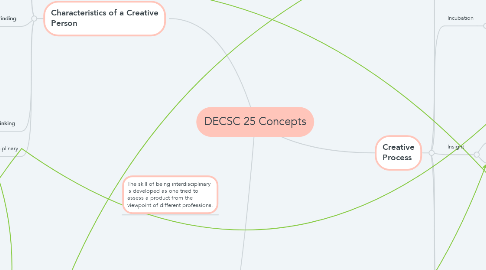
1. Characteristics of a Creative Person
1.1. Lateral thinking
1.1.1. Encouraging out-of-the-box thinking that limits us into thinking the usual way.
1.2. Opportunity seeking
1.2.1. In contrast to opportunity seizers, challenges norms
1.3. Problem finding
1.3.1. Gap Analysis
1.3.1.1. Empathy
1.3.1.1.1. Putting oneself in another's shoes
1.3.1.1.2. Understanding how others feel
1.3.1.2. Customer Journey and Experience
1.3.1.2.1. Thoughts and feelings for each touchpoint of customer journey (e.g., upon ordering, ambiance, upon exit)
1.3.1.3. 5 Why’s
1.3.1.3.1. Going deeper into the root of the problem
1.3.1.4. 5W 1H
1.3.1.4.1. Identifying factors associated to problem
1.3.2. Wicked Problems
1.3.2.1. Complex problems
1.3.2.2. Multi-causal
1.3.2.3. Multi-causal
1.3.2.3.1. For example: Socoeconomic inequality
1.3.2.4. Can only be addressed, not completely solved
1.4. Systems thinking
1.4.1. Seeing events and concepts as part of a bigger picture
1.5. Interdisciplinary
1.5.1. Being able to see things from different standpoints across different disciplines
2. Think Like Leonardo Da Vinci
2.1. Curiosita
2.1.1. Asking questions
2.1.2. Getting deeper insights
2.2. Dimostrazione
2.2.1. Reflection of experiences
2.2.2. Challenging points of view
2.2.3. Learning from mistakes
2.3. Sensazione
2.3.1. extensive use of senses to get insight
2.4. Sfumato
2.4.1. Embracing uncertainty
2.5. Arte/Scienza
2.5.1. Using a combination of the left part of your brain (logic) and right half (creative)
2.6. Corporalita
2.6.1. Taking care of oneself
2.6.2. Cura personalis
2.6.3. Work-life balance
2.7. Connesione
2.7.1. Seeing interconnectedness between seemingly unrelated things
3. Empathy is essential in drafting a persona canvas.
4. Gap Analysis is also part of preparation - understanding the thoughts, feelings, and needs of your customers.
5. The skill of being interdisciplinary is developed as one tried to assess a product from the viewpoint of different professions.
6. One can freely doodle (art) while connecting ideas (logic)
7. Creative Process
7.1. Preparation
7.1.1. Persona Canvas
7.1.1.1. Daily routine
7.1.1.2. Daily struggles
7.1.1.3. Personal hopes and dreams
7.1.2. MAD
7.1.2.1. Feelings and thoughts associated with product/service
7.1.3. SWOT
7.1.3.1. For strategy making, i.e., how to acquire opportunities using strengths or how to minimize threats
7.1.4. PESTEL
7.1.4.1. external environment
7.1.5. Ishikawa Diagram
7.1.5.1. identify root causes
7.1.6. Benchmarking
7.1.6.1. Proxy experiences
7.1.6.2. Compare from competitors
7.2. Incubation
7.2.1. Flow
7.2.1.1. Losing track of time
7.2.1.2. Intrinsic motivation
7.2.2. Virtuous Procrastination
7.2.2.1. Entering the market later
7.2.2.2. Improving first ideas
7.2.3. Brainstorming
7.2.3.1. Facilitating discussion
7.2.3.2. Listing down of ideas
7.2.3.3. Being open
7.2.4. Morphological Analysis
7.2.4.1. Varieties of doing something
7.2.4.2. Mixing and matching
7.2.5. SCAMPER
7.2.5.1. Viewing a product or service on different ways
7.2.6. Reframing Matrix
7.2.6.1. Seeing a product or service from different viewpoints
7.3. Insight
7.3.1. Six Thinking Hats
7.3.1.1. facilitating brainstorming
7.3.2. Mind Map
7.3.2.1. seeing interconnectedness between concepts
7.4. Evaluation
7.4.1. Decision Matrix
7.4.1.1. Considering factors
7.4.1.2. Prioritizing
7.4.2. Creativity Constraints
7.4.2.1. Circles of Competence
7.4.2.1.1. Qualified to contribute an informed opinion?
7.4.2.2. Echo Chambers & Algorithms
7.4.2.2.1. Information a person is consistently exposed to
7.4.2.3. Cultural Bias
7.4.2.3.1. Context
7.4.2.3.2. Non-negotiables
7.4.2.3.3. Priorities
7.4.2.4. Own Assumptions
7.4.2.4.1. Personal example: I am too shy to do something significant.
7.4.2.4.2. Personal example: My classmates always have the right things to say; let them do the talking.
7.4.2.4.3. Personal example: Other people are always right
7.4.2.4.4. These are limiting thoughts that could get in the way of challenging a norm or doing something to address a specific point.
7.4.3. Internal Press Release
7.4.3.1. Transparency to customers about problems and proposed solutions
7.5. Elaboration
7.5.1. Stakeholder Analysis
7.5.1.1. Identifying concerned entities and the effects of your project on them
7.5.2. Ecosystem Map
7.5.2.1. Understanding complex systems by noting interconnections
7.5.3. Gantt Chart
7.5.3.1. Timeline
7.5.3.2. Calendaring
7.5.3.3. Sequencing of pre-requisites required before another action point
7.5.4. Prototyping
7.5.4.1. Testing
